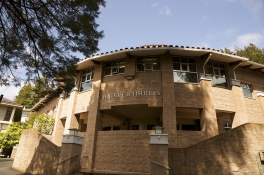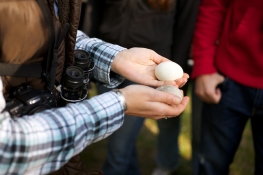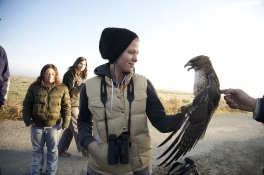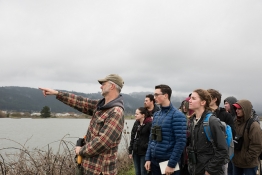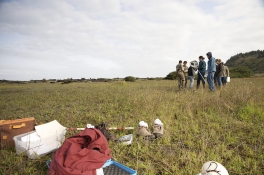Matt Johnson's Dissertation Research
Matt Johnson's Dissertation Research
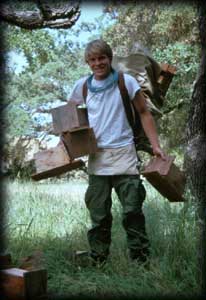
My research career began as an undergraduate at UC Davis, where I volunteered to work on several field research projects including studies of Western Bluebirds near Carmel California, and Swainson's Thrushes breeding in the Sierra Nevada. These experiences not only served as springboards for my career, they also brought me into the field, instilling in me a passion for natural ecosystems and an insatiable interest in the ecology of migratory songbirds. I strongly encourage spirited undergraduates to consider volunteering on research projects to "get a foot in the door;" one never knows where it may lead. A great place to look for field assistant opportunities is the Ornithology Exchange job board or the Texas A&M Wildlife Job Board. Other opportunities can be found by browsing through other ecological organizations' and conservation society webpages, by checking the bulletin boards in the Humboldt wildlife building, or by visiting the career center on campus.
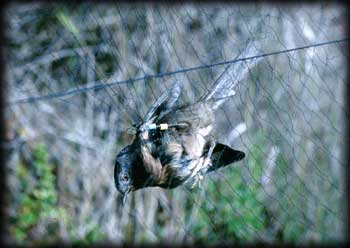
After graduating from Davis with a B.S. in Wildlife Biology, I spent some time working on various short-term wildlife projects to gain more experience. These included monitoring Spotted Owls for the US Forest Service, interning at the Point Reyes Bird Observatory (now called Point Blue Conservation Science) where I learned to band birds, and working in Guatemala on a project investigating the reproductive biology and poaching of Amazona parrots. Then I enrolled in the Department of Ecology and Evolutionary Biology at Tulane University, where I completed my Ph. D. in 1999. My dissertation is entitled "Habitat Relationships of Migratory Warblers Wintering in Jamaica, West Indies," and it focuses on the reasons why warblers are distributed the way they are across the island.
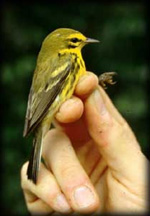
Each fall, after spending the summer breeding in various habitats throughout the United States and Canada, millions of migratory songbirds (like this Prairie Warbler) fly to the tropics, marking one of the most arduous and impressive migrations in the animal kingdom. They spend up to seven months in the tropics each year, feeding to maintain their physiological condition and to prepare for a return trip to temperate breeding areas to reproduce. Many of these migratory songbirds' populations are declining, and much research is currently directed toward understanding why.
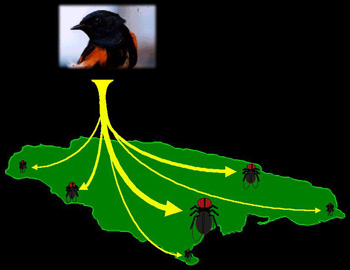
Theoretically, natural selection should lead toward the utilization of available resources, resulting in a match between the distributions of animals and their critical resources. The success of wintering songbirds is primarily dependent on obtaining enough food to survive and prepare for a successful spring migration back to the breeding grounds, and in the Caribbean, most migratory songbirds feed primarily on insects. Therefore, insects may be especially important in influencing the distribution and dynamics of migratory songbird populations on Caribbean islands. Much of my dissertation research focused on investigating the effects of food availability on the distribution and demography of wintering songbirds, especially warblers.
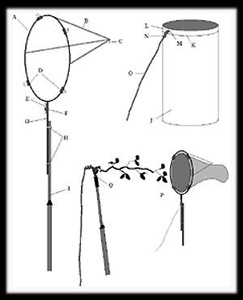
Unfortunately, quantifying food availability for birds that eat minuscule insects by flitting at warp speeds from branch to branch way up in tropical trees is....um...problematic. So my first step was to be an inventor (invention is a large and splendid part of field ecology). I devised a method to sample the foods available to wintering warblers, using the gizmo you see to the right, by hoisting a bag into the forest canopy, enclosing the end of a branch, and capturing the insects clinging to it.
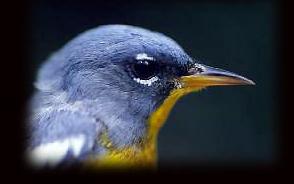
I took thousands of these samples all over the island of Jamaica, and surveyed warblers too, and I found that the abundance of warblers correlated significantly with the biomass of sampled arthropods (insects and spiders). In addition, I found that I could use this correlation to accurately predict the abundance warblers in an area that had experienced an insect irruption simply by measuring arthropod biomass after the irruption. Although not a true controlled experiment, this "natural experiment" made me more confident that the correlation I found exists because food availability in fact influences the distributions of warblers in winter, and is not merely a statistical association.
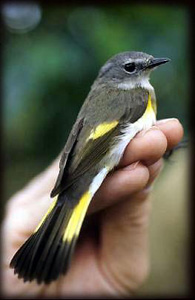
Next, I wanted to learn more about which habitats are good, and which are bad, for warblers wintering in Jamaica. For this work, I focused on a single species, the American Redstart (Setophaga ruticilla), seen at the right. I captured hundreds of these little birds, which weigh less than a quarter of an ounce each, and I put plastic colored bands around their legs so I could individually recognize them in the field. Then I could monitor their lives in a variety of habitats over several years.
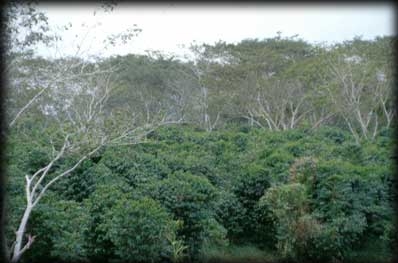
Pooling these data with those of Drs. Thomas Sherry (of Tulane University) and Richard Holmes (of Dartmouth College) and their colleagues, I found that redstarts fared poorly in some habitats and much better in others. Interestingly, I learned that some of the best places for redstarts in Jamaica are "shade coffee plantations," which are not natural habitats at all, but rather managed tropical farms. These coffee farms are comprised of coffee bushes grown beneath a "canopy" of shade trees that are home to many small insects and flowers -- great sources of food for songbirds. Not all farmers use the same tree species to shade their coffee bushes, and my research suggests that a particular species, called Inga vera, is especially attractive to birds. The photo to the left shows a thin canopy of Inga vera trees shading a dense mat of coffee bushes growing beneath them.
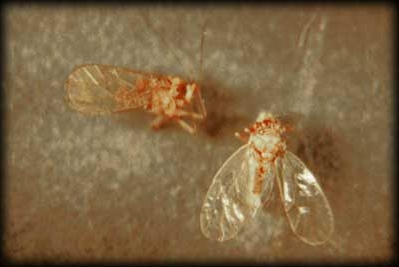
Birds concentrate in these Inga trees because they are dripping with tiny (2-3 mm) insects, such as the little bugs in the photo to the right, called Psyllids. Fortunately for the farmers, the shade trees do not encourage high insect pest populations on the coffee bushes growing beneath them. In fact, other research indicates that the shade trees are not just beneficial for the birds, they are also good for the farmers and their environments. Here's why: Shade grown coffee produces an economically valuable crop without the need for expensive and environmentally destructive pesticides and fertilizers, it retards soil erosion (helping farms last longer), and it enables farmers to gain additional income by harvesting tropical fruits and nuts or wood from the trees that shade their coffee, buffering them from the notoriously unstable world coffee market.
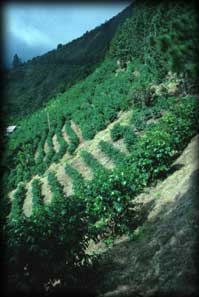
Unfortunately, many tropical farmers today are converting their farms from shade grown coffee farms to "sun coffee farms" (shown at left), without any shade trees at all. This cultivation technique maximizes short term profits because coffee bushes grown in full sun can out-produce (temporarily) those in shade, but only via intensive applications of agrochemicals. Over time, the conversion of shade to sun coffee results in lasting and severe long term economic, social, and ecological damage, including the loss of high quality migratory bird habitat. Thus, for the health of tropical agricultural economies and wintering bird populations, we, as consumers, need to promote the retention of shade grown coffee farms. One of the best ways to do that is to buy coffee that is labeled and certified as "shade grown." A great source for this type of coffee (there are many others) is Thanksgiving Coffee Company, located in Fort Bragg, California. To learn more about shade-coffee cultivation and birds, visit the Smithsonian Migratory Bird Center's web site.
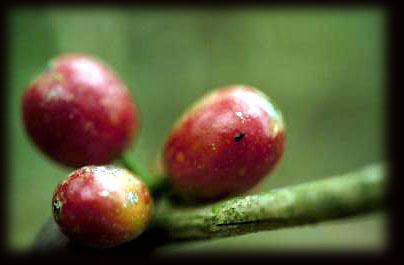
Market based pressure is a good way to promote the retention of shade coffee cultivation, but a more direct economic incentive would be better. Although it's a long shot, I am currently investigating one such possibility. Coffee farmers (especially sun-coffee farmers) spend loads of money to try control insect pests that damage their crop. The most damaging of these insects is a tiny beetle, called the Coffee Berry Borer (black bug on coffee berry seen at right), that digs into ripening coffee berries and ruins the beans inside. If insect-eating birds prey upon this pesky beetle in large numbers, then it would behoove farmers to manage their farms to attract birds to receive some free "insecticide." A good way to attract birds, of course, is to retain the shade trees, which in turn confers additional benefits on the soil, the farmer, and the environment.
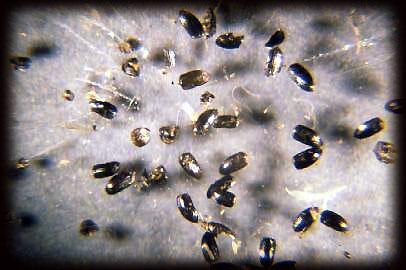
Once at Humboldt, I went to Jamaica with a crew of students (and one Humboldt alumnus) to collect diet samples from warblers in coffee farms. My colleagues and I sorted through these samples, looking for fragments of the coffee berry borer, to determine if and how often the warblers eat the pest. We found a few cases of large numbers of the beetle! The photo to the left is a diet sample from a single American Redstart, and each of those shiny black crescents is a forewing from a coffee berry borer! We used these initial finding to launch subsequent work investigating whether bird could offer any meaningful "biological control" of the pest. That work began when my family and spent our first sabbatical in Jamaica, in the fall of 2005.
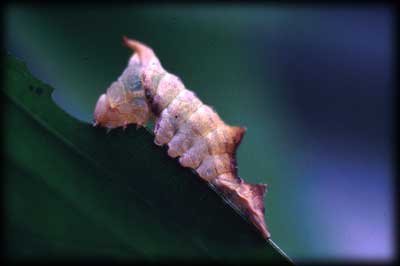
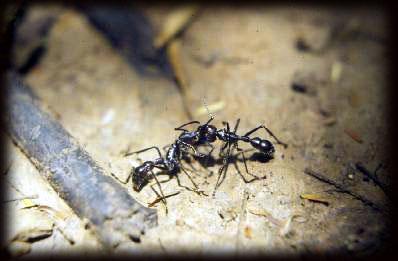
The final phase of my dissertation research focused on the effects of food seasonality on animal communities, a topic I plan to continue to explore with future research. In particular, I examined the partitioning of food between two types of birds -- migratory songbirds, which only spend their winters in the tropics, and birds that breed and spend their whole lives in the tropics, called resident birds. A puzzling paradox in ecology is that migratory insect-eating songbirds arrive in the tropics when overall insect populations reach their annual low point. Testing a hypothesis proposed by Russell Greenberg of the Smithsonian Institution, I found correlative evidence suggesting that the abundance of tropical resident birds is limited by the availability of large, soft-bodied insects suitable as food for baby birds (in order to grow quickly, baby birds need lots of protein found in big, juicy bugs like the caterpillar at the above right). Conversely, the total abundance of all birds during the winter, migratory and resident combined, may be limited by the total availability of all insects, large and small combined. These results suggest that migratory birds exploit a surplus of small, hard-bodied insects (like the ants below right) that is left behind in the winter by the summer-limited resident birds. By invoking the importance of qualitative as well as quantitative changes in food availability, this hypothesis allows for higher total populations of birds during periods of lower food abundance, thereby offering an explanation for the paradox that insects numbers are low when bird numbers are high.
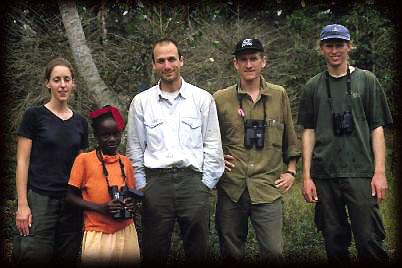
In summary, my research focused on the relationships between birds and their habitats. I am particularly interested in how human impacted habitats can better support bird populations. I feel that an understanding of the ultimate ecological factors that drive wildlife-habitat relationships (such as food availability) is a critical, but often understudied, ingredient in the development of effective conservation and management plans. I also feel it is important for undergraduate students to have opportunities to participate in ongoing and timely research in conservation ecology. I have enjoyed the assistance of numerous undergraduate field assistants in the past, and I eagerly anticipate future collaboration. Thus, I look forward to future research projects that incorporate undergraduate cooperation and focus on the ultimate ecological factors driving habitat relationships of animals in human-modified landscapes.

